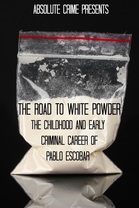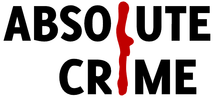The Road to White Powder: The Childhood and Early Criminal Career of Pablo Escobar

Pablo Escobar was one of the most known drug lords of all time. Before he was filling the hands of children with white powder—before he was ordering the execution of government officials—before he was Pablo Escobar the Villain…he was Pablo Escobar the Child.
How does a child from humble and innocent roots grow into someone who wouldn’t think twice about killing another? This book examines the early life and career of Pablo Escobar, and traces the evolution of child to drug lord.
How does a child from humble and innocent roots grow into someone who wouldn’t think twice about killing another? This book examines the early life and career of Pablo Escobar, and traces the evolution of child to drug lord.
Buy Now!
The Road to White Powder PDF and ePub |
Excerpt
Introduction
When Pablo Escobar was buried on December 3, 1993, authorities estimated that some 20,000 people attended his funeral. Some managed to force the lid off the coffin in order to reach inside and touch his face. In fact, the press of the crowd was such that Escobar’s wife and children were unable to even reach the cemetery for the burial.
Certainly some—particularly those who had lost loved ones to random drug-spawned violence or to Pablo’s direct vengeance—were glad to see the kingpin finally lowered into the ground, but many were there to show their support for Escobar and his family. It had taken 500 soldiers and policemen—the sharp end of a task force numbering about 3,000 in all—to corner him after a 16-month chase aided by the Central Intelligence Agency, the National Security Agency, and an unknown share of the $73 million in U.S. aid provided to the Colombian anti-drug campaign in 1993 alone.
Though there is hardly anything unusual in the tale of a man’s life ending at a cemetery, in this case there was a certain irony: one of the many legends surrounding Pablo Escobar was that his first criminal pursuit was selling stolen tombstones.
Chapter 1: A Cradle of Violence
It is perhaps not surprising that in an environment as implacably violent as Colombia, Pablo Emilio Escobar Gavíria was only 44—and that but barely—when he died. He was born December 1, 1949 in Rionegro, a cluster of cattle farms about 25 miles southeast of Medellín which, aside from its now-infamous native son, is most notable today for its location near the south end of the runway of Jose Maria Cordova International Airport. His family was quite pedestrian, upstanding, and solidly middle class, offering no hint of what Escobar would become: his father Abel de Jesús Dari Escobar was a cattle farmer, and his mother Hermilda Gavíria was a teacher. Like so many other Colombians they moved to the city seeking better fortunes and an escape from the violence rending the countryside, relocating to Envigado, a southern suburb of Medellín, in 1950.
Despite later claims to the contrary, Escobar did not grow up in poverty. In The Accountant’s Story, his paean to his younger brother, Roberto Escobar tells what is apparently meant to be a heart-wrenching account of his and Pablo’s youth. He relates how the family had two mattresses; “one of them would be laid on the floor and the children would sleep on it.” He goes on to tell the sorrowful tale of how “we barely had enough for food and Pablo and I would have to walk almost four hours each day to get to school,” leaving at 4 a.m. in order to arrive on time. This book (or Roberto himself, as it was not published until 2009) is apparently the source of the story—since related by multiple sources—that Pablo was once sent home from school because he did not have shoes. Roberto claims that his mother stole a pair of shoes for him and then paid for them later when she received her salary.
The probable truth is much less dramatic, not worthy of any fatherly or grandfatherly tales of a harsh youth spent walking ten miles to school barefoot in the snow, uphill both ways. Having an educated mother set the Escobar children apart to begin with, and at the time Escobar was born his father owned a house, a modest parcel of land, and six cows, and earned additional income tending the holdings of a wealthy landowner nearby. Though the house did not have electricity, it did have running water, and taken together these factors placed the Escobars in the upper middle class of rural Colombia. As a teacher, Hermilda was well-respected in the community and known to all the adults since she taught their children.
Once the family moved into the Medellín suburbs, life improved further. Conditions overall were even better in more urban Envigado, and Escobar was always well-dressed and well-fed. He had many of the same interests as an American boy his age: music, movies, and fast food. His father took a job as a watchman (though perhaps city life did not sit well with him, as he would later return to the countryside to work and is conspicuously absent from accounts of Pablo’s life) and his mother continued to teach. But no matter how conventional his family life, the Colombia of Escobar’s childhood was rife with uncertainty and bloodshed.
The country has a long and sad history of violence. Black humor among Colombians holds that because God made their country so beautiful and so rich in natural bounty, in fairness to the rest of the world He made its people the most evil on earth. Much of the land remains untamed even to this day, its remotest regions all but cut off from civilization. In a 1997 PBS documentary, DEA Special Agent Rollin Pettingill related the story of discovering Escobar’s main cocaine processing facility in 1984. It was so deep in the jungle that “there are no roads that get into this area within one hundred, maybe two hundred miles.” Instead, the facility relied on a network of airfields for its connection to the outside world. The challenges of actually governing such an area are obvious.
When the Spanish colonists arrived in the sixteenth century, they fought for nearly two hundred years to subjugate one of the native tribes, the Tairona, though “subjugate” is probably a poor choice of terminology: the Spanish defeated them only by completely wiping them out. In later years they had little luck governing the region, and even Simón Bolívar, who enjoyed the support of the populace, was unable to unite Colombia, Venezuela, and Peru into “Gran Colombia,” the South American superstate he envisioned.
Thanks to this tradition of ungovernability and its daunting terrain, Colombia has never possessed a strong central government, and by extension law enforcement has had little power in most parts of the country. The two main political parties, the Conservatives and the Liberals, spent the entire nineteenth century at each other’s throats. This period was wracked by eight civil wars, fought mostly over relatively minor differences regarding the role of the Catholic Church in national government. The last and worst, which ignited in 1899, came to be known as the War of a Thousand Days. Its achievements included some one hundred thousand deaths and the complete destruction of the Colombian government and economy.
The common people, then, understandably saw little to admire—or trust—in the establishment. Their loyalty was reserved for the outlaws, the men who offered no allegiance to either side. During the War of a Thousand Days the best known was José del Carmen Tejeiro, who was in essence a darker version of Robin Hood. He stole from wealthy landowners, but the redistribution of wealth by force was not enough for Tejeiro. He would also exact very public vengeance in one form or another; in one case a landowner was required to sign a statement admitting “I was whipped fifty times by José del Carmen Tejeiro as retribution for persecuting him.”[i]
Half a century later, the tired and tragic pattern would repeat itself yet again. The period into which Escobar was born had been named, with heartrending simplicity, La Violencia—the Violence.
La Violencia had its genesis in the April 8, 1948 assassination of politician Jorge Eliécer Gaitán. In a Latin American country still in the grip of the old order—that is, wealth, privilege, and power reserved for the light-skinned descendants of Spanish conquistadors and settlers—the stocky, dark-skinned, Indian-featured Gaitán was clearly an outsider. His popularity among the Colombian masses had grown steadily, especially given the dismal economic conditions prevalent at the time, since many saw in him hope for a man who could bring change without violence. At the time of his death he was head of the Liberal Party and viewed by most as all but certain to win the 1950 presidential election.
Though a Scotland Yard investigation would later opine that Juan Roa, Gaitán’s assassin, was mentally unbalanced and acted alone, there was no shortage of conspiracy theories regarding who was truly responsible. The odds of finding concrete answers diminished sharply when Roa was beaten to death by an enraged crowd at the scene of the shooting, however. And even this rough and immediate justice was but the harbinger of what was to come.
The immediate response to Gaitán’s death came to be known as El Bogotazo, a storm of rioting, looting, and mob violence that originated in Bogotá and fed upon itself and spiraled out of control until President Ospina dispatched the army to bring it under control. Even when the rioting ended, however, the flames of popular resentment continued to flicker, morphing into the less public but still deadly La Violencia, which would eventually claim by some counts 200,000 lives. (Roberto Escobar claims 300,000.) It was ended—or at least mostly quenched—by a 1953 coup that established a military dictatorship under General Gustavo Rojas Pinilla. Five years later yet another coup ousted Pinilla from power, this one mounted by military officers who had more democratic aspirations.
Note: Though the military coup in a “banana republic” has become something of a historical stereotype, the reality in the 1950s and 1960s in Latin America was that a country’s military officers not only commanded obvious power, they were also frequently among the most educated citizens. Moreover, that education was as often as not earned in U.S. universities.
The system of government that was established continued Colombia’s tradition of weak central authority. The rival Liberals and Conservatives were to share power, holding the presidency for alternating four-year terms. But however well-intentioned this arrangement might have been, the reality was that progress essentially halted since each party would undo whatever its rival had done in the prior term. Given such a petulant tug-of-war over power between those who were supposed to lead, there is little wonder that the people had no trust in their institutions.
What inevitably emerged was a government dominated by Colombia’s elites, who as is typical of the wealthy had little interest in change, and opposing it the wilds of the country—the vast majority of its territory—beyond any true control. At first it was the bandidos, existing in the interstices just as they had throughout the War of a Thousand Days, who dominated those outlands. Gradually a relentless campaign by the government and the landowners (who possessed private paramilitary armies, the autodefensas) wiped them out, but by the 1960s they had been replaced by guerrillas, mostly of a Marxist bent as was preponderant throughout the Third World at the time.
Throughout the uncertain times of La Violencia, it was the outlaws and rebels who appealed to the popular imagination. Although they were no less violent than any of the other factions—and in many cases were probably more violent—simply because they were not aligned with any Colombian institution (the government, the industrialists, the labor unions, competing sects of the Catholic Church, and so on), they appealed to the commoners, the campesinos.
These were the heroes of Escobar’s childhood stories: men like Sangrenegra (Blackblood), Tirofijo (Sureshot), Chispas (Sparks), and Desquite (Revenge). The lessons those tales taught were of power and popularity through violence, of the glorification of crime and evading the authorities. Many without the proper talents might have become no more than another petty thug, but Escobar understood on some fundamental level the power of myth—the same mythology that made a rebel and bandit like Robin of Locksley the hero of so many Robin Hood stories. He possessed, as former Colombian president César Gaviria described it, a “genius for public relations” that probably accounts for his widespread charitable efforts aimed at Colombia’s poor later in his criminal career.[ii]
Escobar also became inured to violence, exposed as he was to it throughout his childhood. Roberto tells in his book of harrowing experiences, of guerrillas coming into town “in the middle of the night, dragging people out of their houses and killing them.” His father, he said, told his mother that “they’re going to kill us, but we can save the kids,” after they hid the children under a bed and covered them with blankets. Unable to break through the locked door of the house, the attackers instead splashed gasoline on it and set it afire. Only the arrival of the army, Roberto says, saved their lives. But as soldiers escorted the survivors to the town’s schoolhouse, the scene that was revealed was “bodies lying in the gutters and hanging from the lampposts” and set afire, the stench of burned flesh hanging in the air.
Though he was a capable student as a youngster (and so altruistic as to help his friends with their homework, according to Roberto), his interest in education appears to have waned in his adolescence. A certain degree of uncertainty surrounds his exact educational attainments. While the New York Times noted in passing the day after his funeral that he “finished high school,” many other sources report that he was expelled before graduating. But Killing Pablo author Mark Bowden offers an explanation that is slightly more complicated and thus probably the truth (or at least closest to it). He says that while Escobar indeed dropped out of the Lyceum Lucrecio Jaramillo three years short of graduation, he returned two years later.
Unfortunately for his academic career, he had spent those intervening years engaged in petty crime on the streets of Medellín. Older than his classmates and street-smart, Escobar was generally seen as a bully and even fought with some of his teachers. Expulsion predictably followed before the school year was over. He seems to have taken the graduation exam several times and failed, but eventually he took the direct approach: he simply bought himself a diploma.
Colombian filmmaker Marc de Beaufort claims in his documentary The Private Archives of Pablo Escobar that Escobar briefly attended the Universidad de Antioquia in his home state, though de Beaufort’s film is widely considered an exercise in hero worship and may well stretch (if not utterly fabricate) certain facts. But Roberto mentions in his book as well that Pablo was studying political science there in 1974, though there is no mention of how long that study lasted, only a later allusion that Pablo dropped out because he had no money for tuition. However, considering that in 1974 Pablo controlled a large and quite successful car theft ring in Medellín, had been giving his friends cars stolen directly from factory lots as gifts, and was in the process of moving into cocaine smuggling, it hardly seems credible that he could not afford to pay. That was also the year he was arrested while driving a stolen Renault and spent several months behind bars as a result, so short of correspondence courses from jail the timing seems awkward as well.
But his educational attainments (or lack thereof) aside, by the late 1970s he was a key figure in the cartel that controlled over three quarters of the cocaine trade supplying American yuppies with South American drugs. But even he started as a small-time crook, and it is worth considering how a chubby, unassuming figure like Pablo Escobar reached such a pinnacle of criminal mastery.
[i] Bowden, Mark (2001). Killing Pablo: The Hunt for the World’s Greatest Outlaw. New York: Penguin Books.
[ii] Ibid.








